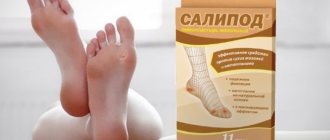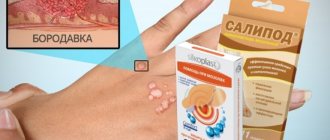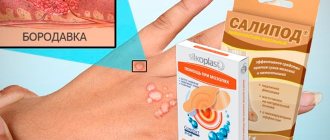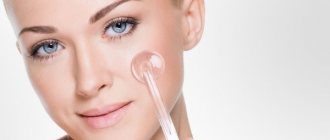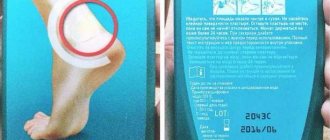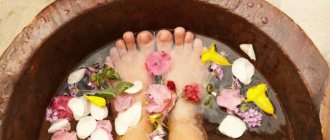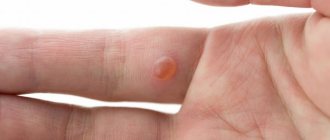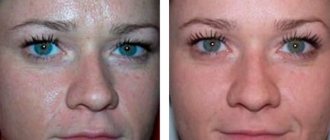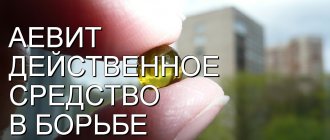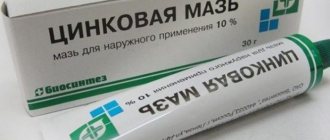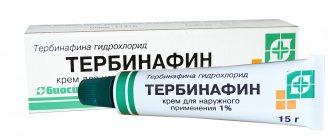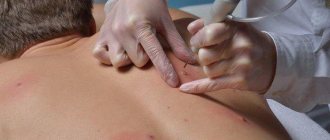The Compid patch for corns is a remedy that can quickly and painlessly eliminate the problem. From wearing tight dress pumps for a long time, areas of rough skin appear on the soles. In places of constant rubbing, the blood supply is disrupted, the upper layer of cells dies, and dry, hard growths gradually form, causing discomfort and pain when walking.
What products are there to remove dry calluses?
Plasters are not a radical treatment method. They can only have a temporary effect. If the factors that provoke the development of corns continue to be present, calluses may appear again, and it is possible that in the same places.
Patches for combating corns are a fairly popular remedy. And there are several reasons for this popularity:
- Safety.
- Ease of use.
- Efficiency (the result is visible after the first use).
Callus patches for the fight and removal of dry calluses, regardless of the brand that produced them, contain two active substances: salicylic acid and sulfur. Manufacturers have developed their own proportions of these substances and additional components. The latter are used:
- Wax.
- Gel or silicone film.
- Analgesics.
- Talc.
To increase the effectiveness of the patches, you need to perform a number of simple steps each time you use them:
- Before applying the adhesive plaster, your feet should be washed and be sure to steam them in water, adding soda and salt.
- After taking a bath, rinse your feet with clean water and dry.
- Before use, it is recommended to warm the patch and, removing the protective cellophane from it, place it on the problem area of the skin.
- Until the end of the period prescribed in the instructions, the patch cannot be removed or even lifted.
- After removing the sticker, your feet should be washed in warm water.
- It is better to rub a neglected old corn with a pedicure grater, scraper or pumice stone.
- Apply a new patch to the cleaned and dried surface.
Note! Chinese patches contain dry ground herbs. Usually such drugs are produced in Korea
Herbs are strong and very effective, but can cause an allergic reaction. They are able to remove not only corns, but also eliminate warts, as well as root calluses.
If you have chronic diseases, it is best to consult a specialist before using patches. Their action often causes skin irritation. This happens if the body is sensitive to the components of the drug or if the patch is applied incorrectly.
Advantages of patches over other drugs
Despite the effectiveness of all of the above methods in the treatment of calluses, patches occupy a leading position.
There are several reasons:
- the patch is available and it’s not just a matter of price - this product can be purchased at any pharmacy;
- convenience - there is a place for a small strip with a therapeutic agent even in a miniature handbag, not to mention a home first aid kit;
- ease of use - the patch can be stuck on the callus and forgotten about it for the next day, and then thrown away;
- wide range - today pharmaceutical companies produce products of various forms, types and medicinal composition.
Corn with a core characteristic features
The main distinguishing feature of a callus is the root/shaft, which is located deep under the skin. This skin formation is difficult to eliminate quickly. While the top can be removed by steaming, the shaft still needs to be reached.
In appearance, a callus is a round area of old, keratinized skin, slightly convex. Upon careful examination, you can see the rod itself. It can also be felt when pressing on the callus (it feels as if someone is poking a needle into this place).
The favorite place for calluses is the soles of the feet (heels and toes), but they can also be found on the hands. Depending on the specialization of a person's work. Musicians, artists, engineers who create drawings of machines, and so on, suffer from calluses on their hands. But athletes, women wearing high-heeled shoes, and postmen are susceptible to calluses on their feet.
The cause of calluses can be:
- Incorrectly chosen shoes (tight, rough material, high heels).
- A splinter or micro-wound with a foreign body can degenerate into a callus with a core.
- Fungal skin diseases.
- Degeneration of an ordinary dry callus. If you do not remove old keratinized skin particles and wear tight shoes, then dead tissue will continue to be deposited on them, and the old tissue will go deeper inside.
A callus can last for years and not cause any discomfort (if it is not on the foot). It tends to become inflamed, resulting in unbearable pain.
Kinds
Compid adhesive plasters are sold in pharmacies, come in several sizes, and are intended to treat various problems:
- corns;
- calluses on the feet (ingrowing, wet, dry);
- calluses between the toes (ingrowing, dry).
Remedies for wet calluses are designed to quickly help with blisters that have already formed. They prevent bacteria from entering the wound, absorb excess moisture, and protect the nerve endings of delicate, unhealed skin from painful touches. Paste directly onto the blister, being careful not to break the swollen skin. Change every few days, as necessary, until the affected area is completely healed.
Remedies for ingrown and dry calluses contain a special impregnation that softens the core and compacted areas of the epidermis, stops further coarsening of adjacent tissues, moisturizes, and has a bactericidal effect.
Compid for eliminating interdigital injuries is distinguished by a convenient shape, reliable fixation, minimizes friction, anesthetizes, and protects against the formation of deep bleeding cracks.
The heels and soles of the feet perform the main supporting function; they have to bear the load of the entire weight. Due to constant pressure, the skin in areas easily coarsens, thickens, forming growths. Adhesive plasters designed to eliminate such problems reduce pressure and mechanical friction of the foot; a humid microclimate eliminates the rigidity of the stratum corneum, accelerates the regeneration process, and relieves inflammation of deep-lying tissues. Change daily or every two days. The cure occurs quickly, the effect is noticeable after the first use.
The company produces another preventative product in the Compid line - a pencil that protects against the appearance of calluses. A thin film of the applied product gently envelops the tissue, reduces friction, relieves pain, and prevents the appearance of blisters. The pencil is invisible on the skin and leaves no marks. Used when wearing open shoes.
The manufacturing company has developed sets of adhesive plasters of various shapes (oval, round, triangular, rectangular) and sizes (large, medium, small), optimally suited for use in a specific area - toe, heel or foot. To make the right choice when purchasing, carefully read the product description information on the packaging.
How the main components of the callus patch work
Thickening and water blisters on the skin cause discomfort and become entry points for germs. It is necessary to treat dry and watery calluses, but with patches with different active ingredients. For example, salicylic acid and urea remove layers of dead cells on the surface of the keratinized growth. Such substances are called “keratolytics”. For water calluses, stickers with an antiseptic and protective effect are used.
How does salicylic acid patch work:
- reduces cracking, inflammation and pain;
- softens and exfoliates the stratum corneum;
- protects the affected area from infection;
- disinfects.
Sulfur in the patch helps retain moisture in the epidermis, enhances the keratolytic effect, and has an antimicrobial effect. Pine rosin is added to enhance the bactericidal effect. Lanolin or silicone is needed to protect the epidermis from abrasion and peeling.
The callus patch softens the dry formation within 2–4 days. After which the growth can be removed with warm soapy water. Getting rid of callus will require longer use of the product.
A water bubble on the heel or toe heals as long as necessary to restore the damaged epidermis. When protected, regeneration occurs quickly and correctly.
Review of patches
The calluses themselves differ in their level of occurrence. Surface corns are easier to deal with than core ones. In the second case, even walking without shoes causes discomfort. The patches disinfect damaged areas, preventing secondary infection. They soften dead tissue and promote their separation.
The list of effective patches includes:
| Name of the patch | Description |
| Salipod . 30% consists of salicylic acid. It is characterized by an antimicrobial effect and accelerates regenerative processes. The patches themselves are compact in size, which allows them to be used precisely without affecting healthy skin. The minimum wearing period is 2 days. For root calluses, you will have to wear the patch for 4 days. The impregnation contains rosin and sulfur. They soften and loosen dense formations. | |
| Compeed . Refers to patches with a gentle effect. It has a hypoallergenic base, but only works with long-term use. Silicone stickers "Compid" attract with a variety of shapes and reliable fixation. They are used to remove calluses on any areas of the feet: between the toes, on the heel, on the side of the foot. Impregnation provides softening and stimulates regeneration. The price of the patches is high, but the product is indispensable for people with increased sensitivity and a tendency to allergic reactions. The transparent sticker is invisible under shoes. | |
| Urgo . Therapeutic patch with salicylic acid and foam backing. Softens callus structures, but cannot be applied to toes. The product is suitable for small calluses on the side and heel surfaces. The therapeutic effect is aimed exclusively at the callus, and healthy tissue is not involved. "Urgo" disinfects, softens and heals, but does not cope well with large calluses. | |
| Luxplast . An effective anti-callus patch with high breathability. Contains salicylic acid. Luxplaster eliminates ingrown calluses, corns, and cracks. Activates skin renewal processes, increases barrier functions, and does not produce a greenhouse effect. The adhesive base is hypoallergenic. Thanks to the cushion under the treatment layer, it is possible to improve tactile sensations while wearing shoes. | |
| Cosmos . Recommended for long-term wear. It has an analgesic effect, enhances trophic processes, and restores the integrity of the skin. Equipped with a hydrocolloid pad that gradually saturates the skin with beneficial substances. At the same time, dead tissue softens and peels off. The Cosmos patch is suitable for the treatment of calluses in adults and children. | |
| Gehwol . Characterized by softening and moisturizing properties. Protects against mechanical stress and discomfort when pressed. Anti-callus patches "Gevol" are indicated for growths of various types: dry superficial and core calluses, wet and purulent formations. The product is convenient to attach to any part of the foot. After treatment, the growths are painlessly removed with a brush or pumice stone. Superficial calluses heal quickly. | |
| Master Uni . Fabric sticker with salicylic acid and protective ring. Helps get rid of dry growths, protects healthy skin from contact with medicinal impregnation. When walking, the fabric base takes the shape of the foot and is not felt. Eliminates old calluses, heals microcracks, enhances regeneration. Suitable for sports and hiking. | |
| Chinese patches . They are effective against corns and old calluses, but have an aggressive composition. The content of salicylic acid in Chinese preparations is higher than in other products. One of the impregnation components is phenol. Chinese patches cannot be used for a long time even if there are no side effects. The maximum permissible period of use is 5 days. The disadvantage of Chinese anti-corn preparations is the inability to securely attach the impregnation to the foot. |
Compeed by Johnson Johnson
Without exaggeration, we can say that Compeed patches were created for all occasions. Compeed can be applied between and on the toes, heels and instep. This product can successfully combat all types of chafing and also prevents their occurrence.
Compeed uses hydrocolloid technology to produce it. Thanks to this, Velcro acts as a second skin. Externally it looks like silicone. Its safe adhesive substance can isolate nerve endings, reducing the intensity of pain. The breathable top layer is able to repel water and protect against friction, bacteria and pressure.
Compeed has the following advantages:
- prevents crust formation;
- waterproof;
- holds even in hard-to-reach places;
- almost invisible on the skin;
- located in a convenient plastic container;
- pleasant to the touch;
- allows the skin to breathe;
- isolates nerve endings;
- protects against moisture and infection.
The manufacturer also produces a gel-like anti-callus pencil. It is applied to damaged skin until it blisters or becomes rough. The product is colorless, making it completely invisible on the skin. Suitable for use by children.
It contains astringent and antiseptic components. The gel stick works as a natural lubricant, instantly reducing friction. In nine out of ten cases, it prevents the formation of blisters.
httpv://www.youtube.com/watch?v=embed/-jN2hPsbBLQ
httpv://www.youtube.com/watch?v=embed/-jN2hPsbBLQ
Sources
- https://healthperfect.ru/plastyr-ot-mozoley-na-nogah.html
- https://nmedicine.net/mozolnyj-plastyr/
- https://www.naturalrating.ru/journal/post/211
- https://fb.ru/article/402951/plastyiri-ot-mozoley-i-natoptyishey-obzor-luchshih-sredstv-instruktsiya-effektivnost-otzyivyi
- https://vseonogah.ru/dermatologija/mozoli-natoptyshi/plastyr-ot-mozolej-na-nogax.html
- https://ladyup.online/kozhnye-zabolevaniya/mozoli/lechenie-m/vybiraem-plastyr.html
- https://polzavred.info/plastyiri-ot-suhih-mozoley
- https://ladyup.online/kozhnye-zabolevaniya/mozoli/natoptyshi/plastyr-ot-natoptyshej.html
- https://palcyruknog.ru/novoobrazovaniya/plastyri-ot-mozolej-na-palcah-nog.html
- https://2Stupni.ru/tovary/plastyr-ot-natoptyshej.html
- https://healthperfect.ru/plastyr-ot-suhih-mozoley-so-sterzhnem.html
- https://transderm.ru/medicinskie-plastyri-i-povjazki/plastyr-ot-mozolej-na-nogah-silikonovyj-gelevyj-ili-tkanevyj
Instructions for use
Before applying the patch, the skin is cleaned and degreased. Creams and lotions should not be used after hygiene procedures - the glue will not stick after them. The patch is placed exactly over the callosal formation. If the size of the drug layer is larger than the affected tissue, then choose a smaller patch. For formations between the fingers and on the little finger, compact impregnations with extended adhesive tape are used.
The sticker stays on the leg for up to 48 hours. They go outside with the patch, sleep, and play sports. If the fixation is secure, replacement of the treatment sticker will not be necessary. If the patch comes off, apply a new one.
The principle of action of the patch on a callus
Patches for calluses and corns act differently, depending on the type of formation on the skin.
Dry callus forms most often. Localized between the toes, on the feet. May occur on the fingers. To eliminate it, choose a patch containing acids. It softens the surface layer and causes dead skin particles to exfoliate. After softening the roughened dermis, the callus is cleaned off mechanically using pumice or a foot file.
A wet callus has fluid inside it that separates the top surface of the skin from the bottom. If such a callus breaks through, erosion will form in its place. The patch protects the bubble from bursting. Creates a barrier that prevents infection.
A callus with a core contains not only dead skin cells, but also a cartilaginous cone in the middle. When you press on such a formation, pain appears. In this case, the patch not only softens the keratinized particles of the dermis, but also dissolves the core inside the callus. This product contains acids and alkalis. The treatment here is longer than in the previous two cases.
To prevent the formation of corns and calluses, special protective stickers are used. Such products are made from silicone. They help avoid friction between the skin and the surface of the shoe. Reduce the likelihood of calluses. Invisible to others and comfortable to wear.
Use as needed
Using corn patches is simple. Is it worth using different approaches to health at the same time? It is not recommended to make excessive attempts to influence the skin, this can only cause irritation. It is better to act intelligently and gradually. Get used to caring for your feet and soles especially. Then you can alternate between traditional medicine, cosmetology, and pharmaceuticals.
Here are the instructions for using Compid patches:
- Take a warm bath. There is no need to steam your feet, a slight warming effect is enough. When you come home from work, use the massage bath, which will allow your legs to relax and forget about the hum. If necessary, add salt or soda to the water - this will help better prepare the skin for large roughness.
Warm bath - Clean the roughness with pumice, a file, or a special grater for feet. First, dry your feet slightly - remove one foot from the water, pat dry with a towel, and rub it with a special tool. Repeat the same with the second leg.
- Rinse and dry extremities. After cleaning the heels, dust, dirt, and remnants of dead skin cells remain on the surface of the skin. You need to get rid of them. Rinse your feet with running water; you should not rinse them in the water where you steamed! After rinsing, dry your skin with a fresh towel and let your feet lie in the fresh air.
- Apply the patch. The patches are in the shape of triangles rounded at the corners and have a light color and a pleasant texture to the touch. Carefully remove the protective film, stick the product on the corns so that the corner “looks” at the fingers, and the others are located parallel to the pads.
- Use for several days. You will immediately understand when to remove this miracle product. The old patch will gradually begin to peel off. Pull the loose corner and discard it.
- Take water procedures by removing the patch. Pour warm water into a basin and soak your feet for 5-7 minutes.
- Remove rough areas. When you take your feet out of the water, you will notice that the corns have visually changed. Carefully remove the softened seal and sand the skin with a file.
Healthy legs
Repeat the procedure if necessary. One session is enough, but if the condition of the soles is terrible, more than 3 procedures will be required until the feet are completely restored! While wearing the patch, try not to tug at it, cut it, or tear it; it contains hydrocolloid particles that affect the skin. If the packaging is damaged, the required impregnation will gradually come out without having the desired effect on the dermis.
Types of skin defects
Calluses are small areas of dead and rough skin. They appear on the body in places where the skin is subject to strong friction, most often the feet or hands. There are four types of callus:
- rod;
- dry;
- water;
- corns
The core is most often located in the area of the little finger or big toe. It is also often found on the heels. This skin defect is characterized by a rigid rod that grows deep into the body. It is difficult to remove, but if this is not done, it will be impossible to walk due to severe pain.
A dry callus rises somewhat above healthy skin. This is an area of keratinized skin that may have a yellowish or grayish tint. Such a formation practically does not cause discomfort, but in an advanced stage it can form cracks, which will cause pain.
Water looks like a bubble with a thin transparent shell. The liquid in the bubble is also transparent, sometimes yellowish and cloudy. In the case where the capillary has been damaged, there may be an admixture of blood. These blisters are usually painful and make walking difficult. If not properly cared for, they can become infected or transform into a solid form.
A corn is a keratinized area of skin that does not have clear boundaries. Most often observed on the feet, and can also form on the hands.
Possible side effects
Salipod adhesive tape for core calluses has a number of side effects that occur quite rarely. The body may respond to the application of the patch with an allergic reaction, which is expressed in the form of symptoms such as:
- itching;
- burning;
- redness.
The above symptoms disappear on their own and do not require discontinuation of treatment. In the case where red spots form in the area where the medication is applied, this sign is one of the symptoms of the development of dermatitis. In order to avoid possible complications, it is recommended to discontinue therapy. This recommendation should be used if signs of inflammation, swelling and attacks of acute pain appear.
It is recommended to stick Salipod so as not to touch healthy skin
Reasons for the formation of growths
Corns and chafing appear as a result of constant squeezing and rubbing of a certain area of the skin. Its cells die, do not have time to exfoliate and accumulate. A rough surface is formed.
On the feet, the formation of growths leads to:
- incorrect gait;
- intense sports (running, skiing);
- shoes with rough internal seams;
- shoes with too thin soles;
- foot diseases (bursitis, flat feet, osteoarthritis);
- high-heeled shoes;
- shoes that are too narrow;
- not using socks.
Despite the fact that these roughness do not pose a threat to health, they can complicate life. Therefore, it is necessary to try to prevent their formation. This is not difficult to do. There are some rules to follow:
- wear only comfortable shoes. It should fit in size, not dangle on the leg and not compress it;
- use socks only made from natural fabrics, such as cotton or wool;
- control weight;
- Every day after a shower, inspect your feet and lubricate the skin with nourishing foot cream;
- do not wear high-heeled shoes every day;
- When going camping or fishing, always take a callus bandage with you.
Effective remedies for treating calluses
Unpleasant formations on the foot from constant friction with shoes did not arise today, and therefore traditional and alternative medicine has a number of effective methods of combating these problems. Each woman will choose a convenient method for herself. Experts note that they can be used in combination, which will achieve quick results.
These methods include:
- Compresses with vegetable oil. It can be regular sunflower, flaxseed, corn, olive or castor. For a compress, thoroughly soak 1 pair of socks in oil, put them on your feet at night, wrap them in a plastic bag and put another pair of socks on top. The advantage of such a compress is that it softens not only the rough callus, but also the entire skin of the feet. In the morning, wash off the oil and wipe the corns with a pumice stone or a rough foot brush.
- Various types of baths in which you need to keep your feet for 20-30 minutes. This can be grated soap with soda (1:2), a pinch of manganese or just salt. All ingredients except manganese are added one teaspoon at a time. Per liter of water. After the bath, you need to scrape off the callus in any convenient way.
- Lotions that it is advisable to do at night: apply a piece of aloe to the callus, tie it tightly with a bandage and scrape off the softened skin in the morning; Grate raw potatoes on a fine grater, place on a cloth or gauze folded several times and tie tightly. Repeat if necessary and remove the callus. Place a lemon peel with pulp on the previously softened skin with calluses and tie. Repeat the procedure for 2-3 days and scrape off the damaged skin.
- Pharmacy products - ointments, creams and plasters. Their composition is similar, since the main therapeutic substances are salicylic and benzoic acids;
- Various types of special procedures: cryodestruction, laser removal, surgical excision. These methods are used as a last resort if treatment at home has not had a positive result.
Features and action of the corns patch
Johnson & Johnson developed an innovative product using unique technology. A medicinal hydrocolloid composition was applied to a waterproof polyurethane base. The principle of operation of the patch is that under the film, upon contact with the callus seal, a gel is formed, creating a constant moist environment. In the watery gel, the hardened epithelium softens, which greatly facilitates the removal of keratinized cells.
The adhesive plaster is made of dense material, protects the problem area from pressure and mechanical irritation, and reduces pain when walking.
Hydrocolloid patches differ from the products we are used to in that they are glued to intact skin. Injury to the surface of the wound when changing the dressing is avoided.
The waterproof base creates a reliable barrier to infection. It sticks so tightly that it does not roll off during intense physical activity or during water procedures in the shower. The components of the Compeed adhesive plaster reduce pain, have an anti-inflammatory and exfoliating effect, and promote rapid healing of the feet. Thanks to the translucent base, it practically merges with the skin, remaining invisible. The elastic elasticity of silicone is able to take the shape of the area to which it is attached. Does not cause discomfort during movements.
Favors proper air exchange in the wound, which protects against the formation of scars.
What are keratolytic agents?
The composition of keratolytic agents usually includes salicylic acid.
You can purchase keratolytic agents at any pharmacy. A doctor's prescription is not required. There is a wide range of keratolytic agents. It can be difficult to stop at just one. Very often, a drug that is effective for one person does not help another person at all. Therefore, you can try several different products and find the right one.
Salicylic acid is usually included in keratolytic agents. It has an antiseptic effect and helps remove the stratum corneum of the epidermis. A corn is a collection of dead cells. This is a protective reaction of the skin to mechanical pressure. Salicylic acid softens such formations. After this, dead skin cells can be easily removed.
Along with salicylic acid, keratolytic agents may include components such as lanolin, petroleum jelly and extracts of various herbs. They also have a softening effect.
It is worth noting that keratolytic agents in the form of ointments and creams are applied strictly to the site of the callus. Do not touch areas of healthy skin. Contact of the product with the mucous membrane should also be avoided. It is recommended to use gloves when treating the sore spot. If the cream gets on the skin of your hands, you should immediately wash them with soap.
The most effective keratolytic agents
You can purchase such medications at any pharmacy. They have many advantages over other anti-corns remedies.
Advantages of ointments and creams:
- natural ingredients in the composition of the products;
- good results in a short time;
- independent treatment;
- low price.
Flaws:
- it is necessary to protect healthy skin around the corns to avoid wounds and burns;
- allergic reactions due to individual intolerance to the components;
- You must remember to use the cream regularly.
Keratolytic agents: features, composition
Before using keratolytic agents, you need to make a foot bath.
Modern medicine offers a large number of ways to solve the problem of corns. You can treat yourself using keratolytic agents. Before using them, you need to make a foot bath.
You can add to it:
- sea salt;
- crushed laundry soap, soda and chamomile infusion;
- 10 ml of ammonia;
- infusion of birch leaves and soda;
- several aspirin tablets;
- table salt;
- oat straw decoction;
- iodine.
Instead of ordinary water, pure herbal decoctions made from nettle, mint, and thyme can be used. They work well on calluses, have a disinfecting effect and help damaged skin recover. Keep your feet in a warm bath with water or broth for at least half an hour. After the corns are carefully treated with pumice or special preparations are used.
Customer Reviews
Most people suffer from the problem of calluses of various types. According to doctors, most often they arise not only because of uncomfortable shoes. The cause may be dry skin, lack of vitamins in the body. Some buyers share their reviews after using such remedies.
I used the Campid callus plaster and really liked it. It is not felt at all on the skin. The callus was large and caused a lot of inconvenience. It helped immediately after use. Now I try to have this product always at hand.
Marina, Kharkov
A friend advised me to buy H Dr. House. It fits perfectly on the foot, which is very important when walking. I advise everyone to buy such an effective and convenient product.
Alla, Perm
I bought Chinese stickers from an online pharmacy and was pleased with the purchase.
Inside is an ointment with salicylic acid. I did everything according to the instructions to remove the growth. After a few days, the skin was soft and tender. Evgeniya, Astrakhan
Callus patches types and names
There are many patches for the treatment of calluses.
The best of them are considered to be such patches as:
Salipod.
This patch allows you to get rid of old calluses that have a core. It is not used to treat wet calluses. Applying the patch to the skin allows you to have a pronounced bactericidal effect. Salipod contains not only salicylic acid, but also sulfur. These components soften even the roughest areas of the dermis well.
Compid.
This is a practical and convenient patch that contains colloidal substances. They make the main active substance viscous, so it does not spread. Compide can be used not only to treat dry calluses, but also to heal wet calluses. For this purpose, a special form of patch is available for sale. They protect wet calluses from friction and pressure. Moreover, the manufacturer took care of producing patches that have a shape that is ideal for use in the spaces between the fingers.
Urgo.
This patch can be used to treat calluses with and without a rod. The patch has a foam pad that prevents medicinal substances from coming into contact with healthy skin and damaging it.
Leiko.
This patch is presented in the form of a thin ribbon. In its very center there is a plastic membrane. It contains the main active components of the patch. At the same time, it itself has excellent air permeability.
Hartmann
cosmos.
This patch is suitable for the treatment of wet calluses. After applying it to the skin, the patch will absorb the secretion, creating a gel-like consistency. It promotes rapid tissue regeneration and pain reduction. Due to the presence of the patch on the callus, the pressure on it is reduced. Dirt, water and bacteria will not get into the wound. The patch contains hydrocolloid.
Salipod
patch.
This patch is suitable for the treatment of dry calluses, corns and skin tags. It is impregnated with sulfur and salicylic acid. In combination, these substances well soften the keratinized areas of the dermis, making it possible to reach the root of the callus and remove it. The main effects of using the salipod patch are: antibacterial, antiseptic, keratolytic and analgesic. Rubber and lanolin enhance the effect of sulfur and salicylic acid. Rosin, which is part of the patch, prevents the proliferation of bacterial flora.
Chinese patches are highly effective. They are limited by a special mesh that securely fixes the device on the skin, but at the same time allows it to breathe.
The best Chinese patches include:
Dr. House.
This patch helps combat dry calluses. Its impregnation contains salicylic acid, which has a pronounced keratolytic effect. The patch is attached to the steamed callus and left on it for 2 days. During this time, the growth will soften and it will be easier to remove. It may take 3-4 treatments to completely get rid of the callus.
Shuyangxuan
is a callus patch that is saturated with components actively used in Chinese medicine. It is represented by adhesive tape, which is equipped with a large membrane. It must be used within 6 days. During this time, the corn or dry callus will become softer and flake off. Using the patch may cause the skin to become red, but this reaction is normal.
Salicilic Acid and Phenol Plasters
for dry calluses and corns The impregnation composition of the patch includes salicylic acid, phenol, wax, petroleum jelly and lamb fat. Together, these components have a pronounced keratolytic, antibacterial and analgesic effect. Apply the patch to the callus steamed in a hot bath, and then leave it for a day. Then the patch must be replaced with a new one. The course of treatment is 3-4 procedures. This Chinese patch is not used to treat wet calluses.
Before using the callus removal patch, you should consult your doctor. Each such patch contains medicinal components, so they should be treated as a medication.
Video: getting rid of calluses with the COMPEED patch:
httpv://www.youtube.com/watch?v=embed/-jN2hPsbBLQ
Features of the salipod patch
The purpose of the Salipod patch for calluses on the feet is to combat keratoses (keratinized areas of the epidermis). It makes the skin softer and exfoliates it. In addition, it is an antiseptic, destroys germs and prevents infection.
A corn preparation is an adhesive plaster on which a composition with medicinal properties is applied. On top it is impregnated with a substance that blocks the entry of water. Available in sizes 10 by 2 cm or 10 by 6 cm in durable paper packaging. There are several units in the pack and an additional regular patch for more reliable fixation of the drug. Convenient use, effectiveness and low cost make it a fairly popular product. It costs about 40−85 rubles.
They try everything to get rid of corns and calluses: compresses, traditional methods, baths. But this does not always give results and takes a lot of time. The effectiveness of the root callus patch is due to its unique therapeutic composition. Among the main components: salicylic acid, which destroys bacteria and fungi , promotes exfoliation of rough cells and penetration of other components deep into the epidermis; sulfur (has healing properties).
Among the excipients:
- rubber;
- rosin;
- lanolin.
List of the most effective products
Patches for calluses and corns are presented in the pharmacy chain in a wide variety. They differ in cost, composition and purpose. The following brands are considered the most popular:
- "Salipod". The product is used to treat calluses of any type. Mount on a pre-steamed surface. Leave for 48 hours, and then the softened skin is cleaned with pumice. The patch costs around 70 rubles.
- Compeed. This brand produces plasters designed for different types of calluses. There are products for dry lesions, wet calluses and for rough skin imperfections. The patch is used as a whole. It cannot be cut into pieces. The product softens the surface of the callus and creates a protective film on it. The price of the drug fluctuates around 300-400 rubles.
- "Urgo." The patch not only heals, but also protects the surface of the skin from friction with shoes. Suitable for both removing dry calluses and combating wet and callus formations. The cost of the product varies within 150 rubles.
- "Space". The patch not only removes the callus, but also restores the integrity of the skin after removal of the formation. Has analgesic properties. It acts on the keratinized surface, destroys it, after which the callus completely moves away from the skin. The product is suitable for different types of calluses. It costs between 130 and 200 rubles.
- Chinese patch. Suitable for core and dry formations. Contains a high concentration of salicylate. The product not only removes calluses, but also relieves itching. Eliminates the inflammatory process. Price – from 70 rubles.
- Liquid patch. Designed for the treatment of wet calluses. It is a gel-like substance that is applied to the formation. When the liquid patch dries, it creates a film that protects the callus from pathogenic microorganisms. Price – from 200 rubles.
- “Mozolin.” The product was created to get rid of dry calluses. The drug is used after the skin is steamed and dried. The patch is worn for two days, after which it is replaced with a new one. It costs around 90 rubles.
- “Leiko.” Effective against dry calluses. Has wound healing properties. Eliminates the inflammatory process. The price for 6 pieces is 70 rubles.
- Dr. House. The patch is aimed at treating dry and core calluses. Contains a protective disc that protects healthy skin from the effects of medications. The main active ingredient is salicylic acid.
These and other patches can easily cope with calluses. They act effectively. Easy to use and invisible while wearing.
Modern removal methods
Consult a dermatologist about removing growths on the soles of your feet and toes. There are effective, painless methods that allow you to get rid of even overgrown formations. A beauty salon or beauty clinic will offer you several effective methods. Professional methods for removing callus:
laser removal. The method is effective in advanced cases. The laser beam is capable of burning the rod to the ground. Another advantage is that during the procedure, pathogenic bacteria that have penetrated the affected area are destroyed. For this reason, the risk of developing an inflammatory process after the procedure is reduced to zero;
hardware callus removal. The doctor uses a special device to “drill out” the formation
It is important to completely get rid of the rod. After the procedure, an antifungal or antibacterial agent is placed in the canal
A correctly performed procedure usually does not cause complications. The risk of relapse is minimal;
cryodestruction. Removing growths using liquid nitrogen is one of the proven methods. Low temperatures “burn out” the painful lump along with the central part. Less than a minute - and the tissues are destroyed. With complete removal, re-germination is virtually impossible.
Growing
ingrown
because there is a depression in its center, and with its rod it grows into the skin.
It is the shaft that makes it most difficult to remove this callus. Subsequently, the skin in this area becomes rough and cracks appear, which cause serious pain.
IMPORTANT! Very often, such calluses, especially large ones, are removed only by surgical drilling. To combat there is also a patch for ingrown calluses, which:
To combat there is also a patch for ingrown calluses, which:
- Softens the skin.
- Helps remove rough areas.
- Heals the skin.
- Reduces pain.
- Disinfects.
